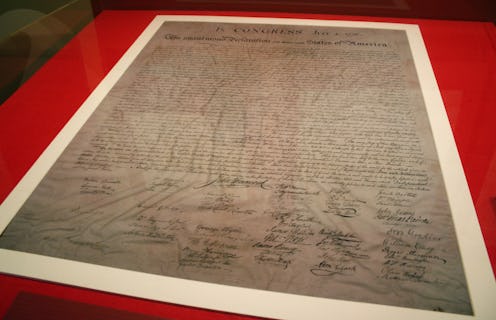Life
The Declaration Of Independence For Beginners

Despite popular belief, the Declaration of Independence is more than just a treasure map used by Nicolas Cage to uncover an elaborate conspiracy. I mean, come on y’all, we all went to middle school, right? But that was maybe a long time ago, and you could use a little refresher: What is the Declaration of Independence exactly? Let me break it down for you.
First, I’ll give you some background on the events that led up to this great country of ours telling the British monarchy to suck it via this very important document. Colonization of what would later be known as the United States of America started in 1607 with the founding of Jamestown, Virginia. Things were pretty good for a while, but after the Seven Years’ War ended in 1763, England was a bit strapped for cash. They were already taxing British citizens up the wazoo, and decided that their American colonists should also pay their fair share. This did not sit well with the colonists, since they felt that without a representative of the colonies in the British Parliament, the government had no right to tax them. The Brits were like, “Too bad, so sad,” and kept raising taxes on things like tea and other goods.
King George III of England sent troops into the colonies to put down the burgeoning rebellion in early 1775 after the Boston Massacre and Boston Tea Party began to whip up the colonists' call for independence. The Continental Congress (which included many of our Founding Fathers) decided they’d had enough of being ruled by the British, and began work on a document that would change the course of history — the Declaration of Independence.
So, how did the Declaration come to be?
I’ll try to keep it short. Since the colonies were essentially their own entirely separate entities, the Congress had no authority to declare independence from England. But as the public outcry for separation grew, a lot of complicated political resolutions and propositions had to be proposed and passed in order for the colonies to be united, and for them to collectively seek independence from England. Once this was all in motion, Congress formed a committee of five men to begin drafting an official declaration.
Who wrote it?
Thomas Jefferson — as a part of a five-man committee that included John Adams of Massachusetts, Benjamin Franklin of Pennsylvania, Robert R. Livingston of New York, and Roger Sherman of Connecticut. Fun fact: Jefferson and the rest of the committee actually wanted Adams to write it, but Adams was like, “Nah, bros. Jefferson, for sure.” So, technically Jefferson wrote the Declaration, but the entire Congress was allowed to make revisions before approving the final draft.
What did the Declaration do?
The decision to sever all political ties from England actually stems from a vote among the delegates of Congress. The Declaration is just the official document that states as such. The vote for independence took place on July 2, but the Declaration was finally approved on July 4. The Declaration also meant that the colonies were now a united government, instead of a collection of separate ones.
What does it say?
The Declaration isn’t as lengthy as the Constitution, thank goodness, but it does have a few important parts. The intro asserts that the colonies are within their rights to become independent, and they’re prepared to explain why.
The Preamble includes what most regard as one of the most important sentences in human history: “We hold these truths to be self-evident, that all men are created equal, that they are endowed by their Creator with certain unalienable Rights, that among these are Life, Liberty and the pursuit of Happiness.” It explains why their rebellion is justified.
Then it goes on to give a long list of all of the things the colonists think King George did wrong, such as forcing the colonists to house British troops, limiting trade, and for disrupting their government. Another fun fact: Thomas Jefferson wanted to include his claim that England had forced the slave trade on the colonies, but the Congress voted to remove it.
And the last parts basically say, “Shame on you, King. America out,” and that everyone signing and supporting the independence was in it together on pain of death or loss of fortunes and honor.
Who signed it?
Fifty-six members of Congress signed the Declaration, the most famous being John Hancock, who thought it was a really cool idea to make his signature hella big.
And the rest, as they say, is history. The Revolutionary War was fought and won (USA! USA! USA!), and we became a full-fledged nation. Today, the Declaration of Independence is stored in the Rotunda of the National Archives building in Washington D.C.